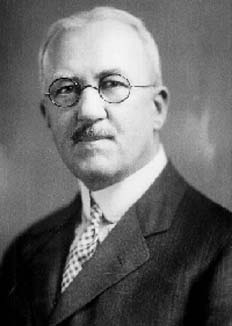
Edward Vermilye Huntington
 المؤلف:
R P Boas
المؤلف:
R P Boas
 المصدر:
Biography in Dictionary of Scientific Biography
المصدر:
Biography in Dictionary of Scientific Biography
 الجزء والصفحة:
...
الجزء والصفحة:
...
 11-4-2017
11-4-2017
 805
805
Born: 26 April 1874 in Clinton, New York, USA
Died: 25 November 1952 in Cambridge, Massachusetts, USA

Edward Huntington's father was Chester Huntington while his mother was Katherine Hazard Smith. Huntington attended Harvard College, and he was awarded his A.B. in 1895, followed by his A.M. two years later. He had already been appointed as an instructor at Harvard after completing his first degree and he held this post while studying for his Master's degree. After being awarded the Master's degree, Huntington was appointed to Williams College.
For two years Huntington worked as a mathematics instructor at Williams College at Williamstown, Massachusetts. The College was a long established one, founded in 1793. In 1899 Huntington left the United States to study for his doctorate in Europe. This was awarded by the University of Strasbourg in 1901. Most American mathematicians of this period who went to Europe to complete their studies chose Germany and, indeed, the city of Strasbourg was German at this time (and in fact called Strassburg). It had been annexed by Germany during the Franco-Prussian War of 1870-71 and would not became French again until after World War I. Huntington's doctorate was awarded for a thesis on algebra.
Returning to the United States, Huntington again was appointed as an instructor in Harvard in 1901. He was promoted to an assistant professor in 1905, then in 1909 he married Suzie Edwards Van Volkenburgh - they had no children. Huntington was promoted to associate professor in 1915 and to professor of mechanics at Harvard in 1919. He retired from this chair, and his other duties, in 1941.
Huntington was interested in the foundations of mathematics. He devised sets of axioms for many mathematical systems, in particular showing that the sets of axioms were independent by giving examples which satisfied all but one of the axioms. He gave axioms for a group, an abelian group, a boolean algebra, geometry, the real number field, and the complex numbers. In 1904 he gave axioms for a boolean algebra then later, in 1933, he showed that a boolean algebra could be defined in terms of a single binary and a single unary operation. This is now known as Huntington's theorem.
Although we have referred above to axioms and axiom systems, we have only done so since this is the modern usage. Huntington himself called these postulates, rather than axioms, and was careful to distinguish between 'postulate' and his own use of the term 'axiom'. For Huntington axiom:-
... should only be applied to statements of fact [including] obviously true statements about certain definite operations on angles or distances.
For Huntington postulates were:-
... conditions which a given system may or may not happen to satisfy.
Huntington's book The Continuum and other types of serial order (1917) was a standard work on set theory for many years. A second edition of this little book consisting of 82 pages was published (also in 1917) and reprinted as a Dover Publication in 1955. Scanlan writes [3] that the book was:-
... a widely read introduction to Cantorian set theory and, although now outdated in method, is still a masterful presentation of the mathematical facts.
One might wonder why, given these interests, Huntington was appointed as Professor of Mechanics in 1919. In fact this was more as a result of his deep interest in methods of teaching mathematics to engineering students than to a research record in the topic. He was, however, interested in several different aspects of applied mathematics. In 1907 he developed log tables which were especially easy for students to use. He was an advocate of the use of calculating machines and he had a mechanical calculator on his desk in his Harvard office. He was also interested in statistics, which was unusual at this time, and he put his knowledge in this area into use during World War I when he worked on statistical problems for the military.
Huntington proposed a method of appointing representatives to the US Congress. This was published as "Edward V Huntington, Methods of Apportionment in Congress. A survey of methods of apportionment in Congress. Senate document no. 304, 76th Congress, Third session. United States Government Printing Office, Washington, 1940". The method was adopted in 1941 and is still used.
In 1919 Huntington was president of the Mathematical Association of America, an organisation he helped to found, and his presidential address considered mathematical problems related to statistics. He was also vice-president of the American Mathematical Society in 1924 and vice-president of the American Association for the Advancement of Science in 1941.
Among the honours he received was election to the American Academy of Arts and Sciences in 1913. He was also elected to the American Philosophical Society in 1933.
- R P Boas, Biography in Dictionary of Scientific Biography (New York 1970-1990).
http://www.encyclopedia.com/doc/1G2-2830902097.html
Articles:
- P W Bridgman, W V Quine, J H Van Vleck and D V Widder, Obituary: Edward Vermilye Huntington, 1874-1952, Bull. Amer. Math. Soc. 59 (1953), 399.
- M Scanlan, Edward Vermilye Huntington, American National Biography 11 (Oxford, 1999), 534-536.
- J H Van Vleck, Obituary: Edward Vermilye Huntington, 1874-1952, The 1952 Year Book of the American Philosophical Society.
 الاكثر قراءة في 1870to1874
الاكثر قراءة في 1870to1874
 اخر الاخبار
اخر الاخبار
اخبار العتبة العباسية المقدسة


